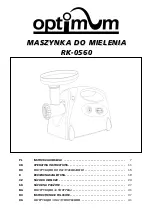
22
8. Care and maintenance
Disconnect the supply cord plug from the socket before
manipulating the DG 150 or DPC 20 (making adjust-
ments, cleaning, etc.).
The ventilation slots in the motor housing must be unob-
structed and kept clean at all times. Do not use metal
objects for cleaning.
Under extreme conditions, conductive dust may collect
inside the tool when grinding mineral materials. This may
have a negative effect on the tool’s protective insulation.
-CAUTION-
Keep the power tool, especially its grip surfaces, clean
and free from oil and grease. Do not use cleaning agents
which contain silicone.
The outer casing of the tool is made from impactresis-
tant plastic. Sections of the grip are made from a syn-
thetic rubber material. Never operate the tool when the
ventilation slots are blocked. Clean the ventilation slots
carefully using a dry brush. Do not permit foreign objects
to enter the interior of the tool. Clean the outside of the
tool at regular intervals with a slightly damp cloth. Do not
use a spray, steam pressure cleaning equipment or run-
ning water for cleaning. This may negatively affect the
electrical safety of the tool.
8.1 Replacing the guard’s lamellar seal
Replace the guard's lamellar seal at least each time the
cup wheel is changed.
-NOTE-
Disassembly / assembly of the seal parts can be
facilitated by rotating the parts of the guard in relation to
each other.
Disassembly
1. Always switch the tool off and unplug the supply cord
before making adjustments to the tool or changing
parts, etc.
2. Use a screwdriver to press the three lugs of the retain-
ing ring over the edge of the guard.
3. Remove the large lamellar seal from the retaining ring.
4. Release the small lamellar seal by pressing with a
screwdriver in the two slots on the outside of the guard.
Assembly
1. Clean the locating grooves to remove large dust par-
ticles.
2. Press the small lamellar seal into the guide in the guard
until it engages.
3. Place the large lamellar seal in the groove in the retain-
ing ring.
4. Press the retaining ring with the lamellar seal over the
edge of the guard until it engages.
8.2 Repairs
The tool has been manufactured and tested with great
care. Nevertheless, in the event of a fault developing, the
tool should be returned to a Hilti service centre for repair.
The tool may be repaired by trained electrical specialists
only.
9. Troubleshooting
9.1 DG 150 indicator lamp (LED)
Overheating of the tool is indicated by the lamp blinking
red. The lamp continues to blink for the duration of the
fault, irrespective of the switch position.
In the event of the lamp blinking red, switch the tool off
and allow it to cool until the red lamp no longer blinks.
9.2 DPC 20 indicator lamp (LED)
Indicator status:
a) Green lamp lights continuously
This indicates that the DPC 20 is ready for operation.
The DPC 20 is connected to the mains supply and indi-
cates no malfunctions. This is the normal status.
b) Green blinking
This may occur with 100 V to 120 V versions when
under load. This indicates that the mains voltage is
too low. The DG 150 reacts by achieving significant-
ly lower performance.
c) Red blinking
This indicates that the DPC 20 is reacting to irregu-
larities in the electric supply (e.g. current or voltage
too high, too low) or to a temperature irregularity. The
indicator changes to green when the problem has been
rectified. If the indicator continues to blink red, unplug
the supply cord from the mains supply, wait a few
seconds and then reconnect it. The output fuses should
be checked if the indicator does not then change to
green.
No indication
The DPC 20 is receiving no power from the mains sup-
ply. This could be caused by the mains supply itself, the
supply cord or extension cable or a fault in the DPC 20.
It is not immediately possible to determine whether the
indicator itself is defective. For this reason, the DPC 20
should be checked together with the DG 150 at regular
intervals, at least every six months, by a trained spe-
cialist or at a Hilti service centre.
10. Disposal
Return waste material for recycling
Most of the materials from which Hilti electric tools are
manufactured can be recycled. The materials must be
correctly separated before they can be recycled. In
many countries, Hilti has already made arrangements
for taking back your old electric tools for recycling.
Please ask your Hilti customer service department or
Hilti representative for further information.
Printed: 08.07.2013 | Doc-Nr: PUB / 5069653 / 000 / 01
Summary of Contents for DG150
Page 2: ...쐏 1 쐇 쐄 쐃 쐂 쐆 쐊 쐎 쐅 Printed 08 07 2013 Doc Nr PUB 5069653 000 01 ...
Page 27: ...24 Printed 08 07 2013 Doc Nr PUB 5069653 000 01 ...
Page 111: ...108 Printed 08 07 2013 Doc Nr PUB 5069653 000 01 ...
Page 113: ...110 Printed 08 07 2013 Doc Nr PUB 5069653 000 01 ...
Page 114: ...111 Printed 08 07 2013 Doc Nr PUB 5069653 000 01 ...
Page 115: ...112 Z Printed 08 07 2013 Doc Nr PUB 5069653 000 01 ...
Page 116: ...113 Printed 08 07 2013 Doc Nr PUB 5069653 000 01 ...
Page 117: ...114 Printed 08 07 2013 Doc Nr PUB 5069653 000 01 ...
Page 118: ...115 Printed 08 07 2013 Doc Nr PUB 5069653 000 01 ...
Page 119: ...116 Printed 08 07 2013 Doc Nr PUB 5069653 000 01 ...
Page 120: ...117 Printed 08 07 2013 Doc Nr PUB 5069653 000 01 ...
Page 121: ...118 Printed 08 07 2013 Doc Nr PUB 5069653 000 01 ...
Page 122: ...119 Printed 08 07 2013 Doc Nr PUB 5069653 000 01 ...
















































